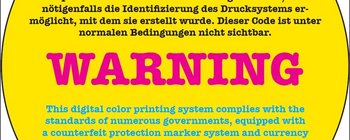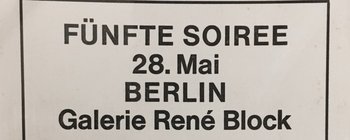
Research Projects
AdA supports international research projects in closer and broader relation to the Archiv der Avantgarden. Besides their own research activities (e.g. in cooperation with other institutions of the SKD or with academic and research institutions), these are mostly projects secured by third-party funding. Partners are research institutions, museums and universities in Germany and abroad.
Between Wild Rumour and a Genuine Account

Between Wild Rumour and a Genuine Account
From Martin Kreysig's class on video-art, I was a student at the Muthesius school of art in Kiel at the end of the 90s, the phrase "The real artist is Sony" was constantly repeated. Every technical innovation that Sony added to its cameras had an immediate impact in contemporary video art. And that concerned not only the inventions and updates, but also the shortcomings of their equipment. The history of technology - from the camera obscura all the way to the glamorizing cameras of our mobile phones - writes our history of art. That was, more or less, the credo I took with me from my studies. Three years ago, two employees of the chair for data protection and safety of TU Dresden prepared a research on tracking dots. Tracking dots (also known as Yellow Dots or Machine Identification Codes) are small, microscopic grid points, which most digital printers and copiers can apply on printouts. With these codes, one can easily track the model and serial number of the printer as well as the date of the printout. A major part of all digital printouts bear watermarks, that are invisible to the human eye and can only be seen with the help of technical tools.
The idea, that so many prints have an invisible picture plane, a kind of subtext beyond the information which printers receive was shocking to me; I considered it an attack on my artistic integrity, because printing texts and images have been fundamental to my artisitic practice for years.
A conversation with Stephan Escher, one of the authors of the mentioned study, helped me to better understand the phenomenon. Among other things, he pointed out that parallel to his research, the whistleblower Reality Leigh Winner had been caught with the help of Tracking Dots. Apparently, intelligence services and law enforcement shared our interest in Tracking Dots. I wanted to conduct further research on the matter. In contrast to the scientists, my position was that of a data subject, who was entangled in a practice with a double ground I had not seen before. So I got a USB microscope and investigated the printouts of my studio printer and it was true - it printed yellow dots. I tested the equipment of the copyshops in my vicinity and they also produced tracking dots. From there, I developed the idea to establish a comprehensive database. In an Open Call I urged people to download the prepared PDF from my Website, to print on digital printers and to send those printouts to me. This procedure had already been used by the EFF (Electronic Frontier Foundation) from the US since 2005.
INVITATIONS

INVITATIONS
A collaboration between the Archiv der Avantgarden at Staatliche Kunstsammlungen Dresden, Freie Universität Berlin and Haus der Kulturen der Welt Berlin, the research project "Invitations" attempts to create an alternative and accessible narrative of the artistic avant-garde along invitation cards to exhibitions and events from the past hundred years. Providing information about attitudes, participating artists and organisers, designs and publications, the invitation is a medium usually given little attention. It offers punctual encounters in artistic projects and reveals hints to the formation of movements, aesthetic concepts, their conditions, social movements and groups.
Focusing on invitations to historically relevant art exhibitions and their crossings with design, architecture, music, film, theatre and performance, the project highlights the avant-garde’s networks – its key actors, institutions and visions. Additional material highlights these narrations, such as photographs, manifestos, correspondences, films, editions or objects, which are located in the archive as well. Next to a digital web platform launched in the beginning of 2019, the "Invitations" project will be presented in a publication in 2019 and prospectively in an exhibition, as well as it will include workshops and other participatory events open to the public.
Anna-Lena Werner is a researcher, curator and writer. Researching artistic networks from the 20th century through the inventory of invitation cards at the Archiv der Avantgarden, she is part of a collaborative project between the state museums of Dresden, Freie Universität Berlin and Haus der Kulturen der Welt in Berlin. She studied at Chelsea College of Art and Design in London and at Freie Universität Berlin, where she handed in her Ph.D. dissertation on representations of social traumata and political conflicts in contemporary, aesthetic positions in 2018. During her studies she has been research associate for "Black Mountain Research" –– a performative research project between Freie Universität Berlin and Hamburger Bahnhof - Museum für Gegenwart - Berlin. Anna-Lena Werner regularly organises exhibitions and happenings in project spaces and galleries, such as Savvy Contemporary (Berlin) or Blok Art Space (Istanbul), and she publishes texts in magazines, such as Monopol – Magazin für Kunst und Leben, Schirn Magazin or Performance Research. Since 2011 she runs the online and print magazine artfridge, which features interviews with artists and curators.
